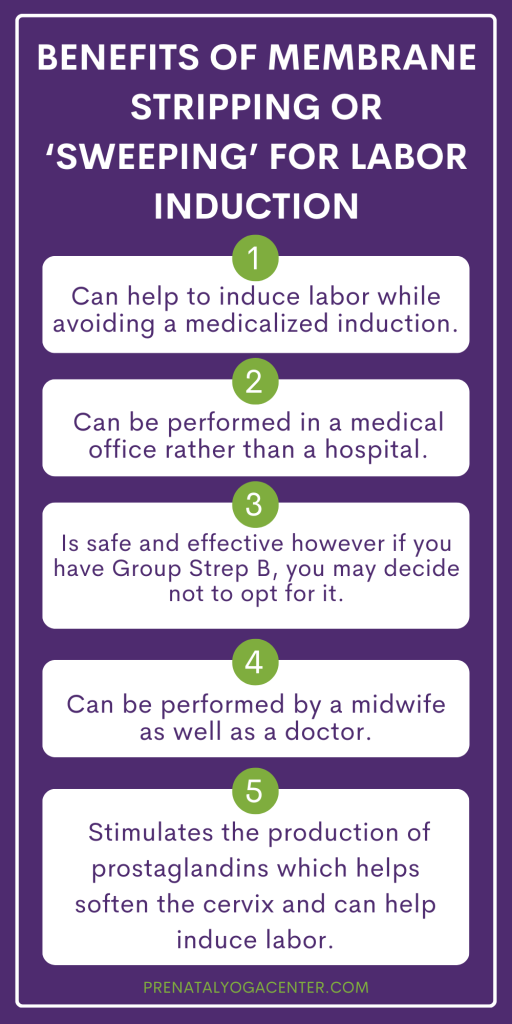A few weeks ago, one of my good friends was facing labor induction. She was a week beyond her estimated due date and her doctor wanted to induce 10 days past. My friend had tried just about everything to get things moving. I had asked her if her doctor had tried stripping her membranes (also sometimes called “sweeping the membranes”). She said no. Her doctor did not believe in this method of induction. I found this response interesting since I had not heard of a doctor opposing this option. Which of course, led me to exploring this subject even further and writing about it!
Navigation
What is Membrane Stripping?
This is one of several options for those who would like to avoid a more medicalized induction and try an alternative method to kick-start labor. While there are many “do it yourself” natural methods for induction, this is not one of them. This procedure needs to be performed by a midwife or doctor and can be done in a medical office, not the hospital. If the cervix is open enough the doctor or midwife will insert two fingers inside the cervix and separate the amniotic sac from the cervix.
Why is it Done?
Stripping the membranes stimulates the production of prostaglandins which helps soften the cervix and can help induce labor. If the cervix was so closed that the care provider could not strip the membranes, then cervidil or cytotec would be inserted vaginally to deliver prostaglandin directly onto the cervix to help it soften and prepare for dilation.
What to Expect from Getting Your Membranes Stripped
Many people say they feel rather crampy afterwards and have a little spotting. However, it should be mild spotting, not a copious amount of blood. I have had some students report back that they have even started to feel full-on contractions afterwards.

What are the Risks of Membrane Stripping?
If you have had a vaginal culture that says you have group B strep (GBS) in your vagina, you may not want to have your membranes stripped; there are no studies that I have found that show stripping membranes is harmful if you have GBS in your vagina and no studies that have shown it is safe if you have GBS in your vagina, so this is a decision you should make with your provider.
In my research, I have also heard some doctor’s shying away from this procedure in fear that this will cause the amniotic sac to rupture. Although, according to the doctors and midwives I have consulted, they all said that this is very unlikely.
To rupture the amniotic sac from stripping the membranes, either there needs to be a direct intention to do so or the amniotic sac is very weak to begin with. When an amniotomy (purposeful rupturing of the membranes) is performed, it is done so with a special instrument, such as an amnihook or amnicot, that looks much like a crocheting needle. It is not that easy to rupture the membranes with two finger tips.
What are the Benefits?
As mentioned before, stripping the membranes is an effective non-pharmaceutical way to induce labor.
For those who have seen their due dates come and go and face medical induction, you now have a new option to discuss with your care provider. For some, this could be an exciting new avenue to explore, and for others just more information to store away. As I always stress, there is no “right way” to give birth, there are endless possibilities!
We regularly discuss various aspects of pregnancy and child birth during our yoga classes. Click below to join one of our online or in person classes!
FAQs
How Long After Stripping the Membranes Until Labor?
The onset of labor after membrane stripping can vary widely among individuals. Some may experience labor within hours, while for others, it might take a few days. There’s no guaranteed timeframe, as it depends on how ready the body is for labor.
How Painful is Membrane Stripping?
The experience of pain during membrane stripping can vary. Many people report feeling discomfort or cramping during the procedure, and some may experience mild spotting afterward. The level of pain or discomfort is subjective and can differ from one person to another.
Is Membrane Sweep Very Painful?
Similar to the question above, a membrane sweep can be uncomfortable or mildly painful for some, but not necessarily for everyone. It involves a physical examination and manipulation of the cervix, which can cause discomfort. Communicating with your healthcare provider about your pain tolerance and concerns can help manage expectations.
How Dilated Do You Have to Be for a Membrane Sweep?
For a membrane sweep to be performed, the cervix needs to be slightly dilated and effaced enough for the healthcare provider to insert a finger into the cervical opening. Typically, being at least 1-2 centimeters dilated is necessary, but this can depend on the judgment and experience of the provider.

